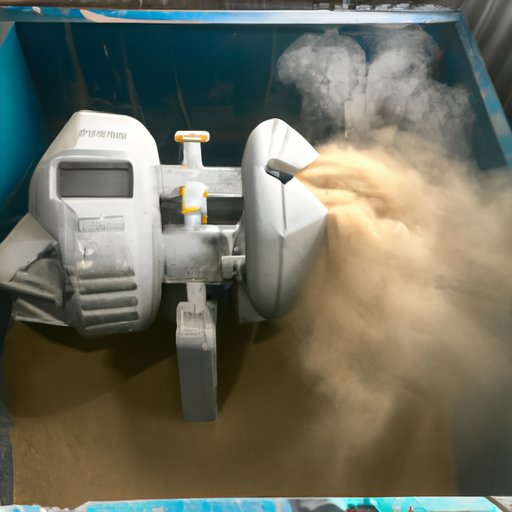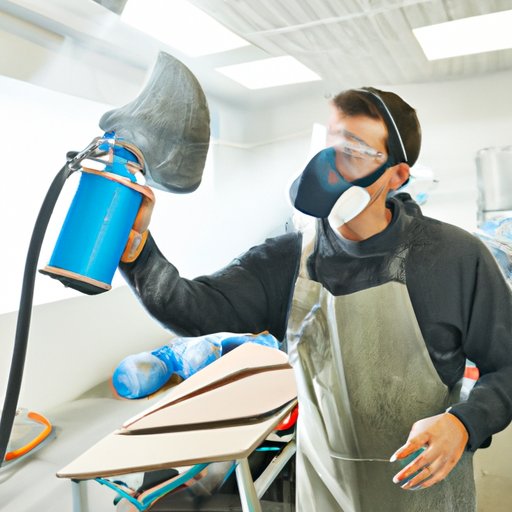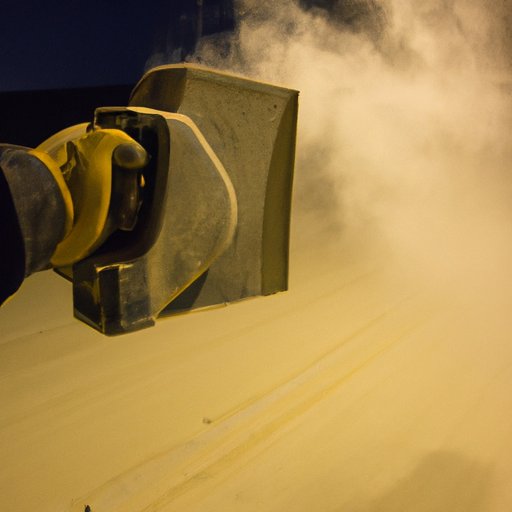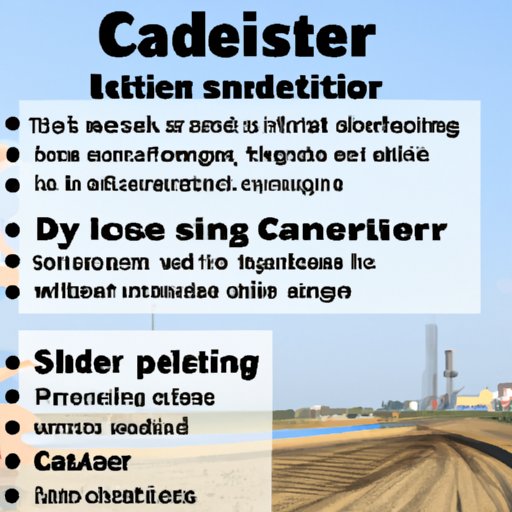Introduction
Sandblasting is a popular technique used to remove paint and rust from metal surfaces, clean masonry, etch glass and plastic, and prepare a surface before applying a new layer of paint. The process involves shooting an abrasive material at high pressure onto a surface to strip away the top layer. This article will explore how a sandblaster works, including the components and process of sandblasting, as well as its benefits compared to other methods, different types of sandblasters, and tips for troubleshooting common problems and staying safe while using one.

Exploring the Components of a Sandblaster and How They Function
A sandblaster consists of several components that work together to create a powerful stream of abrasive material. These components include:
Pressure Tank
The pressure tank is the main component of the sandblaster and is usually made of steel or aluminum. It holds the air or gas needed to power the sandblaster, and the pressure inside the tank is regulated by a pressure gauge. The pressure tank can be powered by either an air compressor or a gas-powered engine.
Nozzle
The nozzle is attached to the pressure tank and directs the flow of abrasive material. The nozzle has two openings – one for the abrasive material, and one for the air or gas. The size of the nozzle determines the size of the abrasive particles, which affects the speed and intensity of the blasting process.
Abrasive Material
The abrasive material is typically a type of sand or grit, such as silica sand, aluminum oxide, or steel shot. The type of abrasive material used depends on the surface being blasted and the desired results. The abrasive material is stored in a hopper and fed into the nozzle through a tube or hose.
Hose
The hose is used to connect the pressure tank to the nozzle and carries the air or gas needed to power the sandblaster. The length and diameter of the hose determine the pressure of the sandblasting process.
A Step-by-Step Guide to the Sandblasting Process
Once the components of the sandblaster are assembled, the sandblasting process can begin. Here is a step-by-step guide to help you get started:
Preparing the Area
Before beginning the sandblasting process, it’s important to prepare the area by clearing away any debris or objects that could be damaged by the abrasive material. It’s also important to cover any areas that should not be blasted, such as windows or electrical outlets.
Selecting the Appropriate Abrasive
The type of abrasive material used will depend on the surface being blasted and the desired results. Generally, finer abrasives are used for softer materials, while coarser abrasives are used for harder materials. It’s important to select the right abrasive material for the job to ensure optimal results.
Setting Up the Sandblaster
Once the area is prepared and the appropriate abrasive material is selected, the sandblaster can be set up. This involves connecting the pressure tank to the nozzle and filling the hopper with the abrasive material. Once everything is connected and filled, the pressure tank can be turned on and the sandblaster is ready to use.
Applying the Sandblaster
To apply the sandblaster, hold the nozzle about 12 inches away from the surface and move it in a sweeping motion. Start at one end of the surface and work your way across until the entire surface has been blasted. Once the blasting is complete, the pressure tank can be turned off and the sandblaster can be disassembled.
The Benefits of Sandblasting Compared to Other Methods
Sandblasting offers several advantages over other methods of surface preparation, such as:
Cost Savings
Sandblasting is generally much less expensive than other methods of surface preparation, such as chemical stripping or manual sanding. In addition, the abrasive material can be reused multiple times, further reducing costs.
Speed and Efficiency
Sandblasting is a fast and efficient method of removing paint, rust, and other contaminants from a surface. The high-pressure stream of abrasive material quickly strips away the top layer, making it ideal for large projects.
Versatility
Sandblasting can be used on a variety of surfaces, from metal to concrete, and can be used to clean, etch, or remove paint. It can also be used for decorative purposes, such as engraving or creating patterns on glass and plastic.
An Overview of Different Types of Sandblasters
There are three main types of sandblasters: gravity-fed sandblasters, suction-fed sandblasters, and pressure sandblasters. Here is an overview of each type:
Gravity-Fed Sandblasters
Gravity-fed sandblasters use gravity to feed the abrasive material into the nozzle. These sandblasters are generally used for small projects and do not require a compressor or gas-powered engine. They are lightweight and easy to use, but they have a limited range.
Suction-Fed Sandblasters
Suction-fed sandblasters use a vacuum to draw the abrasive material into the nozzle. These sandblasters are more powerful than gravity-fed sandblasters and have a longer range, but they require a compressor or gas-powered engine to operate. They are often used for larger projects.
Pressure Sandblasters
Pressure sandblasters use compressed air to force the abrasive material into the nozzle. These sandblasters are the most powerful type and can reach greater distances than gravity-fed and suction-fed sandblasters. Pressure sandblasters require a compressor or gas-powered engine and are often used for industrial applications.

Troubleshooting Common Problems with Sandblasting
Although sandblasting is a relatively simple process, there are a few common problems that can occur. Here are some tips for troubleshooting these problems:
Clogged Nozzle
A clogged nozzle can cause the sandblaster to lose pressure and reduce the effectiveness of the blasting process. To unclog the nozzle, turn off the pressure tank and blow out any debris with compressed air. If this doesn’t work, replace the nozzle with a new one.
Poor Blasting Results
If the blasting results are poor, check the pressure tank to make sure it is functioning properly. If the pressure is too low, the abrasive material will not be propelled with enough force to effectively remove the top layer. Adjust the pressure accordingly.
Leaking Pressure Tank
If the pressure tank is leaking, turn off the pressure tank and inspect all connections for loose fittings. Tighten any loose connections and check for cracks or damage in the pressure tank. If there is no visible damage, replace the pressure tank with a new one.

Safety Tips for Using a Sandblaster
It’s important to take safety precautions when using a sandblaster. Here are a few tips to keep in mind:
Wear Proper Clothing
Always wear protective clothing, such as goggles, gloves, and a dust mask, when using a sandblaster. This will help protect your eyes, skin, and lungs from the abrasive material.
Use Approved Respiratory Protection
When sandblasting, it’s important to use approved respiratory protection, such as a respirator or dust mask, to prevent inhalation of the abrasive material. This is especially important when working with silica sand, which can be hazardous when inhaled.
Follow Manufacturer’s Instructions
Always follow the manufacturer’s instructions when using a sandblaster. This will help ensure proper setup and operation, as well as help prevent accidents.
Conclusion
Sandblasting is a popular technique for removing paint and rust from metal surfaces, cleaning masonry, etching glass and plastic, and preparing a surface before applying a new layer of paint. The process involves shooting an abrasive material at high pressure onto a surface to strip away the top layer. This article explored how a sandblaster works, including the components and process of sandblasting, as well as its benefits compared to other methods, different types of sandblasters, and tips for troubleshooting common problems and staying safe while using one.
(Note: Is this article not meeting your expectations? Do you have knowledge or insights to share? Unlock new opportunities and expand your reach by joining our authors team. Click Registration to join us and share your expertise with our readers.)
